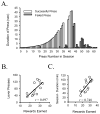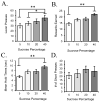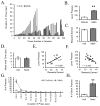A novel strategy for dissecting goal-directed action and arousal components of motivated behavior with a progressive hold-down task
- PMID: 26030428
- PMCID: PMC4451610
- DOI: 10.1037/bne0000060
A novel strategy for dissecting goal-directed action and arousal components of motivated behavior with a progressive hold-down task
Abstract
Motivation serves 2 important functions: It guides actions to be goal-directed, and it provides the energy and vigor required to perform the work necessary to meet those goals. Dissociating these 2 processes with existing behavioral assays has been a challenge. In this article, we report a novel experimental strategy to distinguish the 2 processes in mice. First, we characterize a novel motivation assay in which animals must hold down a lever for progressively longer intervals to earn each subsequent reward; we call this the progressive hold-down (PHD) task. We find that performance on the PHD task is sensitive to both food deprivation level and reward value. Next, we use a dose of methamphetamine (METH) 1.0 mg/kg, to evaluate behavior in both the progressive ratio (PR) and PHD tasks. Treatment with METH leads to more persistent lever pressing for food rewards in the PR. In the PHD task, we found that METH increased arousal, which leads to numerous bouts of hyperactive responding but neither increases nor impairs goal-directed action. The results demonstrate that these tools enable a more precise understanding of the underlying processes being altered in manipulations that alter motivated behavior.
(c) 2015 APA, all rights reserved).
Conflict of interest statement
Figures







References
-
- Aberman JE, Ward SJ, Salamone JD. Effects of Dopamine Antagonists and Accumbens Dopamine Depletions on Time-Constrained Progressive-Ratio Performance. Pharmacology Biochemistry and Behavior. 1998;61:341–348. - PubMed
-
- Anaclet C, Parmentier R, Ouk K, Guidon G, Buda C, Sastre J-P, Akaoka H, Sergeeva OA, Yanagisawa M, Ohtsu H, Franco P, Haas HL, Lin JS. Orexin/Hypocretin and Histamine: Distinct Roles in the Control of Wakefulness Demonstrated Using Knock-Out Mouse Models. The Journal of Neuroscience. 2009;29:14423–14438. - PMC - PubMed
-
- Antoniou K, Papadopoulou-Daifoti Z, Hyphantis T, Papathanasiou G, Bekris E, Marselos M, Panlilio L, Müller C, Goldberg S, Ferré S. A detailed behavioral analysis of the acute motor effects of caffeine in the rat: involvement of adenosine A1 and A2A receptors. Psychopharmacology. 2005;183:154–162. - PubMed
-
- Antonitis JJ. Response variability in the white rat during conditioning, extinction, and reconditioning. Journal of Experimental Psychology. 1951;42:273–281. - PubMed
-
- Barr AM, Phillips AG. Withdrawal following repeated exposure to d-amphetamine decreases responding for a sucrose solution as measured by a progressive ratio schedule of reinforcement. Psychopharmacology. 1999;141:99–106. - PubMed
Publication types
MeSH terms
Substances
Grants and funding
LinkOut - more resources
Full Text Sources
Other Literature Sources
Research Materials
Miscellaneous

